A set of globes from c. 1640.
Stewart Museum, Canada.
This set of globes - a terrestrial globe (left) from c. 1645 - 1648 and a celestial globe (right) from after 1630 - was made in Holland by the Bleau family. Each globe has a diameter of 68 cm and was thus obviously designed to impress visitors in a rich household.

Large globes could carry much detailed information and had to be updated frequently to keep up with the latest exploratory voyages. The terrestrial globe shown here carries a note in northwestern America that says:
- "After a route to the eastern lands had been opened by the Portuguese ... round the Cape of Good Hope, many people ... tried to find a shorter route north and northwest to those same most abundant lands and to the Moluccas, renowned over the whole world. In particular, there were Gaspar and Miguel Corte-Real, Portuguese brothers, in 1500 and the two following years, and after them Sebastian Cabot, a Venetian, in 1507. In a similar way, after the strait [of Magellan] had been conquered ... there have been some famous and outstanding navigators who ... tried another, by the same north and northwest passages ... Among them were ... Martin Frobisher in 1576 and '77, and John Davis in '85, '86 and '87. ... Even if, after almost incredible suffering and toil, their attempts have failed, nevertheless Henry Hudson, also an Englishman, and after him certain Dutchmen sent out from Amsterdam did not stop. ... In 1611, this Hudson, sailing along the shores of North America, at a latitude of 61°, 62° and 63°, as our globe indicates, through a long strait, found at the end a huge and widely spread sea, the discovery of which gave hope to many that some passage might be found there in the end. Whether the outcome will bear out these expectations within a short time, as we hope, time itself will show."
Reference
Dahl, E. H. and J.-F. Gauvin (2000) Sphæræ Mundi, early globes at the Stewart Museum. Septentrion - Mc gill-Queen's University Press.
home

